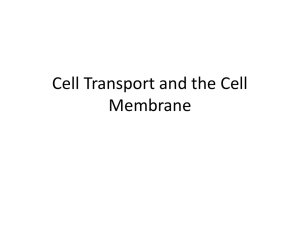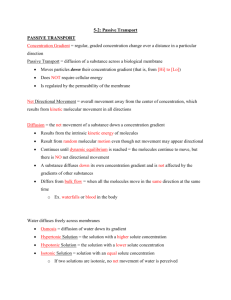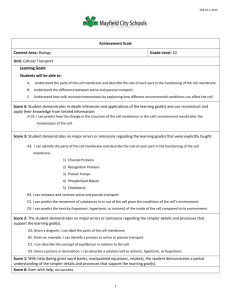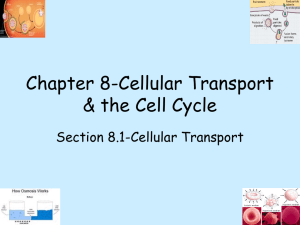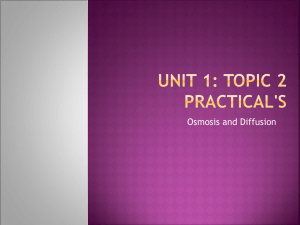Task - Science - Grade 7
advertisement
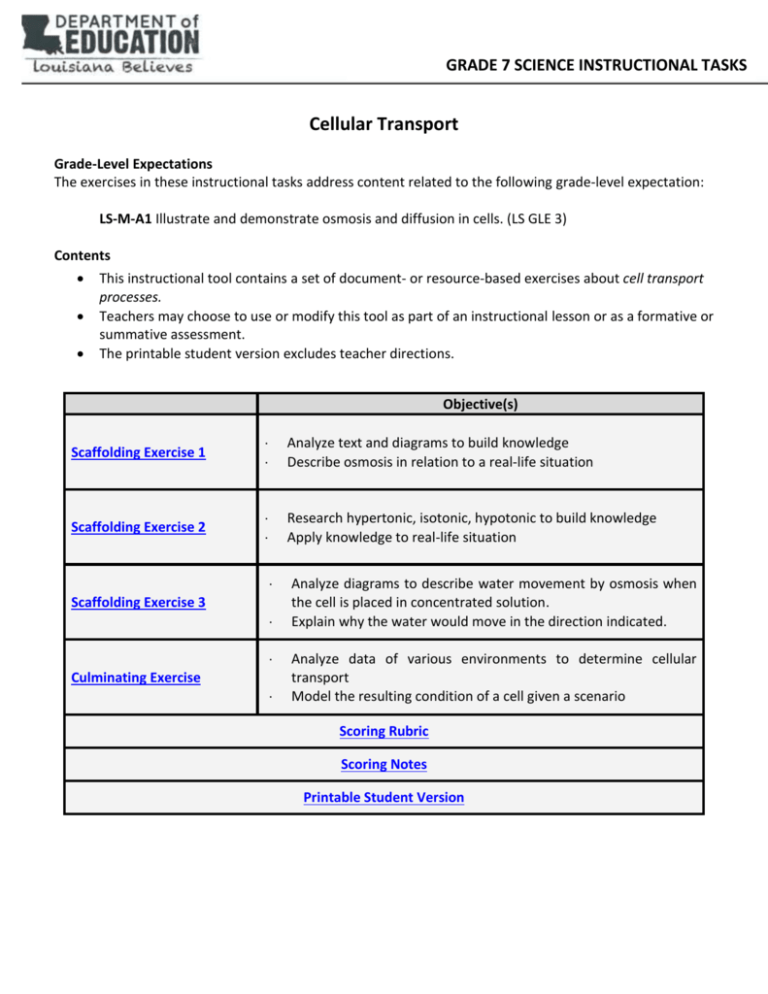
GRADE 7 SCIENCE INSTRUCTIONAL TASKS Cellular Transport Grade-Level Expectations The exercises in these instructional tasks address content related to the following grade-level expectation: LS-M-A1 Illustrate and demonstrate osmosis and diffusion in cells. (LS GLE 3) Contents This instructional tool contains a set of document- or resource-based exercises about cell transport processes. Teachers may choose to use or modify this tool as part of an instructional lesson or as a formative or summative assessment. The printable student version excludes teacher directions. Objective(s) Scaffolding Exercise 1 Analyze text and diagrams to build knowledge Describe osmosis in relation to a real-life situation Scaffolding Exercise 2 Research hypertonic, isotonic, hypotonic to build knowledge Apply knowledge to real-life situation Scaffolding Exercise 3 Culminating Exercise Analyze diagrams to describe water movement by osmosis when the cell is placed in concentrated solution. Explain why the water would move in the direction indicated. Analyze data of various environments to determine cellular transport Model the resulting condition of a cell given a scenario Scoring Rubric Scoring Notes Printable Student Version Teacher Directions: Have students study the following information to respond to the prompt. Scaffolding Exercise 1 Cells draw on materials from their environments to sustain cellular functions. The structure of a cell membrane plays an essential role in maintaining a cell's health. As a semi-permeable plasma membrane it serves as a barrier between a plant or animal cell's cytoplasm and the surrounding extra-cellular fluid. Water moves across the cell membrane through the process of osmosis which is a form of diffusion, a passive transport. Cells are at equilibrium and healthier when the concentration of water and solutes is the same inside the cell as the concentrations outside the cell. Lipids Proteins Small Portion of a Plasma Membrane When you think about a membrane, imagine it is like a big plastic bag with some tiny holes. That bag holds all of the cell pieces and fluids inside the cell and keeps undesirable things outside the cell. The holes are there to let some things move in and out of the cell. The holes represent protein channels. The cell membrane holds all of the cell pieces and fluids inside the cell and keeps undesirable things outside the cell. The channels are there to let some things move in and out of the cell. A student investigated the effects of temperature on osmosis in a potato. He placed cylinders of potatoes into beakers of salt solutions at different temperatures. He then recorded the change in mass of the potatoes. He found that as the temperature of the salt solution increased, the percentage of mass the potato lost also increased. Explain and illustrate the reason potato cylinders lose mass when placed in salt solutions. Teacher Directions: Have student research the words hypertonic, isotonic, and hypotonic. Fill in the following chart and respond to the question below. Scaffolding Exercise 2 Description Hypertonic Isotonic Hypotonic Why do hospitals use saline solution in a patient’s IV? Illustration Teacher Directions: Have students examine the models and information below to respond the questions. Concentration Key Isotonic Scaffolding Exercise 3 Same as Cell Hypertonic Highly Concentrated Hypotonic 100 % water Cells 1 2 3 Environments A B C Environment B represents fluids containing waste products such as blood moving from the veins into the kidney. Analyze what would happen if cell 2 were placed in environment B. How would placing the cell in this environment affect the movement of water across the cell membrane? Give two reasons for this movement. Culminating Exercise Teacher Directions: Have students study the information below to complete the task. Environment 1 Environment 2 Original Environment 1 Environment 2 Solutes 10% 12% 5% Water 90% 88% 95% A single cell organism begins in its original environment. It gets washed into a sewer drain (Environment 1), where it adapts to maintain homeostasis. It then gets washed out of the sewer drain into a river of clear water (Environment 2). Again, it adapts to maintain homeostasis. A. Sketch a model of the cell in environment 1, using shading or labeling to indicate concentrations. Draw arrows to indicate the direction that water will move between the single-celled organism and the environment to maintain equilibrium. B. Sketch a model of the cell in environment 2, using shading or labeling to indicate concentrations and draw arrows to indicate the movement of water that would reach and maintain equilibrium. C. Describe the resulting change in the cell when it is in the river water. D. Model the resulting condition of the cell if placed in an environment of 100% water for 12 days. Rubric Key Elements: A Response illustrates the cell in Environment 1 and the direction of water flow in this environment. B Response illustrates the cell in Environment 2 and the direction of water flow when cell is in this environment. C Response correctly describes the resulting change in the cell in river water. D Response models what will occur if the cell remains in 100% water for 12 days. Response includes all four key elements. 4 Points Response contains no scientific errors. Response includes three of the four key elements. 3 Points Response may include scientific errors. Response includes two of the four key elements. 2 Points Response may include scientific errors. Response includes one of the four key elements. 1 Point Response may include scientific errors. Scoring Notes The following are examples only. All reasonable, valid responses should be accepted. Part A: The sketch for this part will illustrate the cell only a slightly lighter shade than the sewer water or label the cell as 10% and environment as 12%. Arrows will indicate that only a slight amount of water will move out of the cell into the environment until equilibrium is reached. Part B: The sketch for this part will illustrate the cell a darker shade than the river water (Environment 2) or label the cell as 12% and environment as 5%. Arrows will indicate that water will move from the cell into the environment until equilibrium is reached. Part C: In river water that has a weaker concentration of solvents, the cell will swell as it absorbs additional water from the environment. Part D: Student models show that the cell has burst. Because the cell contains solvents, it can never reach equilibrium with a 100% water environment. It will continue to absorb water until the membrane bursts. Through osmosis, the water will move from where there is more water to where there is less water until the concentrations are equal. (That is why the water will continuously move into the cell if it is immersed in 100% water.). Other Resources: http://regentsprep.org/regents/biology/2011%20Web%20Pages/Cells-%20Cell%20Transport.htm http://zoology.okstate.edu/zoo_lrc/biol1114/tutorials/Flash/Osmosis_Animation.htm http://highered.mheducation.com/sites/0072495855/student_view0/chapter2/animation__how_diffusion_works.html Printable Student Version Teacher Directions: Have students study the following information to respond to the prompt. Cells draw on materials from their environments to sustain cellular functions. The structure of a cell membrane plays an essential role in maintaining a cell's health. As a semi-permeable plasma membrane it serves as a barrier between a plant or animal cell's cytoplasm and the surrounding extra-cellular fluid. Water moves across the cell membrane through the process of osmosis which is a form of diffusion, a passive transport. Cells are at equilibrium and healthier when the concentration of water and solutes is the same inside the cell as the concentrations outside the cell. Proteins Proteins Lipids Small Portion of a Plasma Membrane When you think about a membrane, imagine it is like a big plastic bag with some tiny holes. That bag holds all of the cell pieces and fluids inside the cell and keeps undesirable things outside the cell. The holes are there to let some things move in and out of the cell. The holes represent protein channels. The cell membrane holds all of the cell pieces and fluids inside the cell and keeps undesirable things outside the cell. The channels are there to let some things move in and out of the cell. A student investigated the effects of temperature on osmosis in a potato. He placed cylinders of potatoes into beakers of salt solutions at different temperatures. He then recorded the change in mass of the potatoes. He found that as the temperature of the salt solution increased, the percentage of mass the potato lost also increased. Explain and illustrate the reason potato cylinders lose mass when placed in salt solutions. Directions: Research the words hypertonic, isotonic, and hypotonic. Fill in the following chart and respond to the question below? Description Hypertonic Isotonic Hypotonic Why do hospitals use saline solution in a patient’s IV? Illustration Directions: Examine the models and information below to respond the questions below the images. Concentration Key Isotonic Same as Cell Hypertonic Highly Concentrated Hypotonic 100 % water Cells 1 2 3 Environments A B C Environment B represents fluids containing waste products such as blood moving from the veins into the kidney. Analyze what would happen if cell 2 were placed in environment B. How would placing the cell in this environment affect the movement of water across the cell membrane? Give two reasons for this movement. Directions: Explore the information below to respond to prompts A – D. Environment 1 Environment 2 Cell Environment 1 Environment 2 Solutes 10% 12% 5% Water 90% 88% 95% A single cell organism begins in its original environment. It gets washed into a sewer drain (Environment 1), where it adapts to maintain homeostasis. It then gets washed out of the sewer drain into a river of clear water (Environment 2). Again, it adapts to maintain homeostasis. A. Sketch a model of the cell in environment 1, using shading or labeling to indicate concentrations. Draw arrows to indicate the direction that water will move between the single-celled organism and the environment to maintain equilibrium. B. Sketch a model of the cell in environment 2, using shading or labeling to indicate concentrations and draw arrows to indicate the movement of water that would reach and maintain equilibrium. C. Describe the resulting change in the cell when it is in the river water. D. Model the resulting condition of the cell if placed in an environment of 100% water for 12 days.
